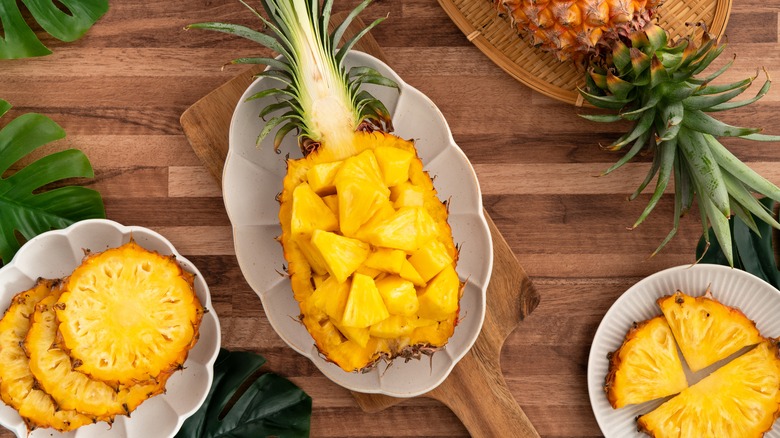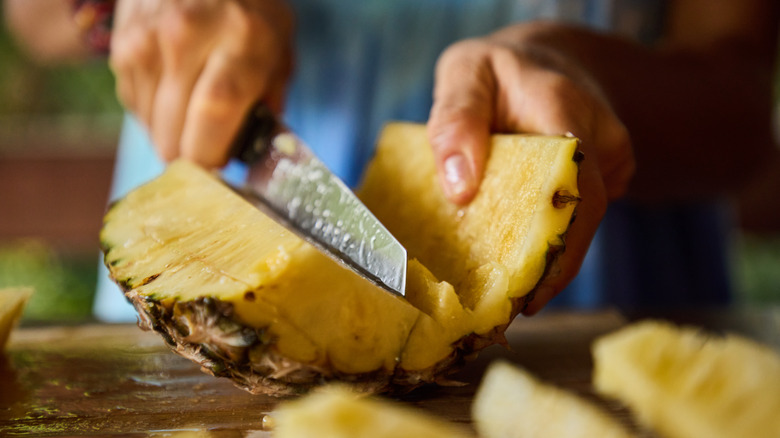The Pineapple Color Test To Determine If It's Perfectly Ripe
Pineapples are refreshing tropical fruits filled to the brim with vitamins and beneficial compounds. With their distinctive sweet, tangy, and acidic taste, they go great in all kinds of recipes, from a beach-vibes piña colada to the more controversial Hawaiian pizza. Unlike avocados, though, few people realize that pineapples can taste different depending on their ripeness and even the time of day, becoming juicier at the perfect moment (FYI, they're sweeter in the morning). But how can you tell whether a pineapple is ripe or not? To find out, Food Republic consulted William Goldfield, director of communications at Dole Food Company, who revealed that the secret key to the fruit's ripeness is simply inspecting the colour of its skin.
"[T]he skin should be golden yellow, the color progressing in intensity from the bottom to the top," he told us. "Stay away from entirely green, dark yellow or orange fruit. These are either underripe or overripe." Unlike dark yellow or orange are signs the pineapples are overripe, while green is a sign they're underripe.
You can also check ripeness by looking at the leaves at the crown. "They should be shiny green and slightly waxy and not brown and crusty," Goldfield told us. If you're unsure, try pulling out one of the leaves. "[I]f the leaf pulls right out, it means you have a winner," Goldfield said. Brown and crusty leaves are an indicator of over-ripeness and potential rotting, so if you spot them, it's best to leave the pineapple on the shelf. If it's been sitting at home, you can blend it into smoothies, juices, or cocktails, or you could add it to your compost pile (just avoid using too much due to its acidity).
Weight, smell, and firmness also indicate ripeness
The color of the pineapple's skin isn't the only way to indicate ripeness. If you're out shopping and feeling indecisive about which fruit to pick, there are several practical ways you can tell whether it's worth buying or skipping. According to William Goldfield, one simple way to determine ripeness is to "weigh the fruit in your hands." "The heavier it is, the more likely it is to be ripe, juicy, and tender," he explained. This is a sure sign that the pineapple will be juicier. A slightly more unusual yet equally effective way to tell ripeness is to "smell the base." "A ripe pineapple should give off a sweet, fruity aroma," Goldfield added. If it has no aroma, it might be underripe, and if it has a more pungent smell, it's a sign of overripeness and rotting, so it's best to skip that one.
Another indicator is the squeeze test. "You want it to be mostly firm but with some give," Goldfield told us. "Avoid pineapples that feel mushy or are soft enough for your fingers to leave an indentation." A hard shell is also a sign that the pineapple is not ripe just yet. While many people claim that unripe pineapples can ripen faster if turned upside down at room temperature, Goldfield shot down this idea. "Since pineapples are non-climacteric, meaning they only ripen when attached to the parent plant," he explained. "This can't be true. Once a pineapple is picked, it stops ripening. So, it's best to cut and eat your pineapple within a few days of bringing it home."


